-

大班数学活动:小小裁判员课件教案
一、 活动目标:1、 学习用记录统计的方法比较物品的多少,感知数学在生活中的作用。2、 探索运用自己喜欢的方式进行记录,从中比较出最快速最清楚的记录方法。3、 尝试商讨合作式的学习,学会肯定自己和倾听他人的意见。二、 活动准备1、 录音机、磁带;小猫、小狗、小兔木偶;金牌一枚;画有小猫、小狗、小兔的记录纸和空白表格若干,记号笔人手一支2、 大格子图及皮球、沙包、绳子;
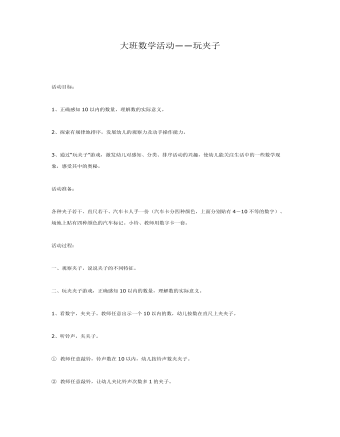
大班数学活动――玩夹子课件教案
2、探索有规律地排序,发展幼儿的观察力及动手操作能力。3、通过“玩夹子”游戏,激发幼儿对感知、分类、排序活动的兴趣,使幼儿能关注生活中的一些数学现象,感受其中的奥秘。活动准备:各种夹子若干、直尺若干、汽车卡人手一份(汽车卡分四种颜色,上面分别贴有4-10不等的数字)、场地上贴有四种颜色的汽车标记。小铃、教师用数字卡一套。活动过程:一、观察夹子,说说夹子的不同特征。二、玩夹夹子游戏,正确感知10以内的数量,理解数的实际意义。1、看数字,夹夹子。教师任意出示一个10以内的数,幼儿按数在直尺上夹夹子。2、听铃声,夹夹子。① 教师任意敲铃,铃声数在10以内,幼儿按铃声数夹夹子。② 教师任意敲铃,让幼儿夹比铃声次数多1的夹子。

大班数学活动——月历宝宝课件教案
二.活动目标1.初步理解年月日的概念,感知年月日之间的关系;运用不同的数数法探究:一年有12月个月,一个月30(28、31)天,一年有365天。2.引导幼儿知道有记录时间“年月日”的叫做日历。日历有年类之分,种类之别。活动重点:运用不同的数数法探究:一年有12月个月,一个月30(28、31)天,一年有365天。活动难点:大小月分别是哪几个月?顶小月又是哪个月?三.活动准备1.大字卡“年、月、日、1、4、7、12、31、30、28、365”各一张;自制外形似房子状的2005年1月——12月的月历(大月、小月、2月数房子大小有区分);小字卡(年、月、日)数字卡(12、30、31、28、365)幼儿人手一份。2.各类挂历、台历、月历、日历。
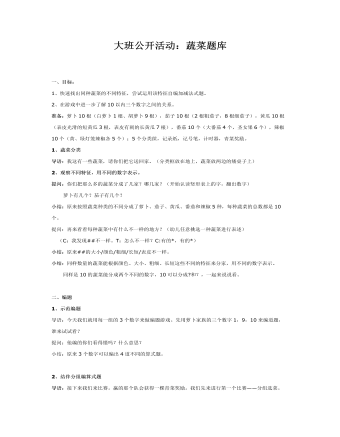
大班数学活动:蔬菜题库课件教案
2、在游戏中进一步了解10以内三个数字之间的关系。准备:萝卜10根(白萝卜1根、胡萝卜9根),茄子10根(2根粗茄子,8根细茄子),黄瓜10根(表皮光滑的短黄瓜3根,表皮有刺的长黄瓜7根),番茄10个(大番茄4个,圣女果6个),辣椒10个(黄、绿灯笼辣椒各5个);5个分类筐,记录纸,记号笔,计时器,青菜奖励。1、蔬菜分类 导语:我这有一些蔬菜,请你们把它送回家。(分类框放在地上,蔬菜放两边的矮桌子上)2、观察不同特征,用不同的数字表示。 提问:你们把那么多的蔬菜分成了几家?哪几家?(开始认读竖形表上的字,翻出数字) 萝卜有几个?茄子有几个? 小结:原来按照蔬菜种类的不同分成了萝卜、茄子、黄瓜、番茄和辣椒5种,每种蔬菜的总数都是10个。 提问:再来看看每种蔬菜中有什么不一样的地方?(幼儿任意挑选一种蔬菜进行表述)
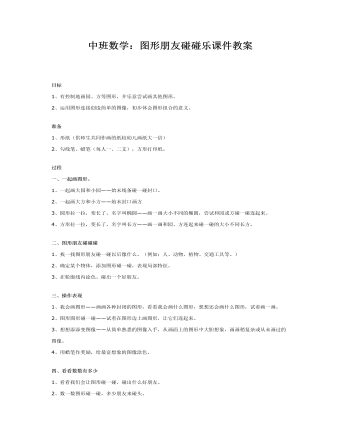
中班数学:图形朋友碰碰乐课件教案
2、运用图形连接创造简单的图像,初步体会图形组合的意义。准备1、形纸(供师生共同作画的纸较幼儿画纸大一倍)2、勾线笔、蜡笔(每人一、二支),方形打印纸。过程一、一起画图形。1、一起画大园和小园——始末线条碰一碰封口。2、一起画大方和小方——始末封口画方3、圆形拉一拉,变长了,名字叫椭圆——画一画大小不同的椭圆,尝试和园或方碰一碰连起来。4、方形拉一拉,变长了,名字叫长方——画一画和园、方连起来碰一碰的大小不同长方。二、图形朋友碰碰碰1、找一找图形朋友碰一碰以后像什么。(例如:人、动物、植物、交通工具等。)2、确定某个物体,添加图形碰一碰,表现局部特征。3、在轮廓线内涂色。碰出一个好朋友。
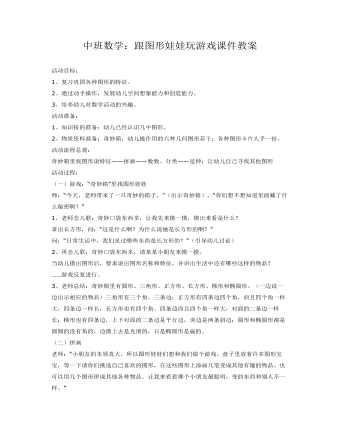
中班数学:跟图形娃娃玩游戏课件教案
2、通过动手操作,发展幼儿空间想象能力和创造能力。3、培养幼儿对数学活动的兴趣。活动准备:1、知识按的准备:幼儿已经认识几中图形。2、物质资料准备:奇妙箱,幼儿操作用的六种几何图形若干;各种图形卡片人手一份。活动流程总观:奇妙箱里找图形说特征——拼画——数数、分类——延伸:让幼儿自己寻找其他图形活动过程:(一)游戏:“奇妙箱”里找图形娃娃师:“今天,老师带来了一只奇妙的箱子。”(出示奇妙箱),“你们想不想知道里面藏了什么秘密啊?”1、老师念儿歌:奇妙口袋东西多,让我先来摸一摸,摸出来看是什么?拿出长方形,问:“这是什么啊?为什么说她是长方形的啊?”问:“日常生活中,我们见过哪些东西是长方形的?”(引导幼儿讨论)2、再念儿歌:奇妙口袋东西多,请某某小朋友来摸一摸。当幼儿摸出图形后,要求说出图形名称和特征,并讲出生活中还有哪些这样的物品?……游戏反复进行。

中班数学:礼物送给好妈妈课件教案
活动准备: 礼物卡片,统计表。数字1——7 活动过程: 我给妈妈送礼物 ——将礼物事先放在教室的周围桌子上 ——展示7种礼物卡,幼儿说出礼物卡上的内容,数数一共有几种礼物。 ——猜猜妈妈会喜欢那种礼物,并选择一种最想送给妈妈的礼物统计礼物的数量 ——手那相同礼物统计表的幼儿围在一起,数一数一共有几个人 ——教师出示统计表,请每组派一名幼儿早统计表上画上相应数量的符号 ——数一数那组人数最多,那组人数最少,

中班数学:动物宝宝去春游课件教案
二、活动准备: 幼儿人手一张图画纸,图纸中间是一个小动物的妈妈(教师事先画好)幼儿在动物妈妈的周围画上动物宝宝,数量以6—10不等。如小动物有小熊、孔雀、大象、等等都是幼儿熟悉的。三、活动过程: 1.天气越来越暖和了,我们小朋友去上海动物园春游,小动物看到有这么多小朋友去看它们,非常高兴,它们听说嘉定有儿童公园,它们也想来玩玩。 2.动物妈妈带了许多宝宝,我们先来帮助动物妈妈数数有几个宝宝。 (1)、幼儿人手一份图画纸,分别数数有几只动物宝宝。 重点观察:幼儿寻找被数物体的起始点和终止点并能正确进行数数。
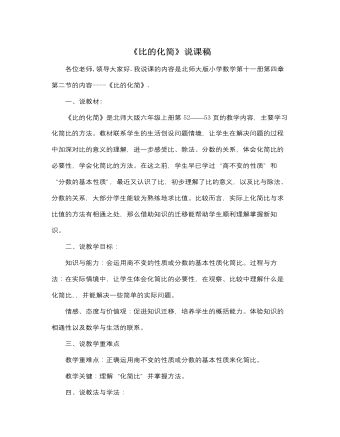
北师大版小学数学六年级上册《比的化简》说课稿
《比的化简》是北师大版六年级上册第52——53页的教学内容,主要学习化简比的方法。教材联系学生的生活创设问题情境,让学生在解决问题的过程中加深对比的意义的理解,进一步感受比、除法、分数的关系,体会化简比的必要性,学会化简比的方法。在这之前,学生早已学过“商不变的性质”和“分数的基本性质”,最近又认识了比,初步理解了比的意义,以及比与除法、分数的关系,大部分学生能较为熟练地求比值。比较而言,实际上化简比与求比值的方法有相通之处,那么借助知识的迁移能帮助学生顺利理解掌握新知识。二、说教学目标:知识与能力:会运用商不变的性质或分数的基本性质化简比。过程与方法:在实际情境中,让学生体会化简比的必要性,在观察、比较中理解什么是化简比,,并能解决一些简单的实际问题。情感、态度与价值观:促进知识迁移,培养学生的概括能力。体验知识的相通性以及数学与生活的联系。
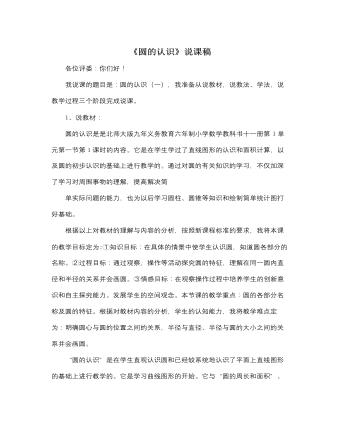
北师大版小学数学六年级上册《圆的认识》说课稿
④联系生活实际解决身边的问题,让同学初步感受数学与日常生活的密切联系,体验数学的应用,促进学生的发展。接下来,我再具体谈一谈这堂课的教学过程。3、说教学过程第一环节:创设情境,激qing导入。同学们你们看屏幕上的是什么?(出示图片)那么自行车车轮是什么形状的?为什么车轮要设计成圆形?这里面有什么奥妙呢?学了今天的内容大家就会明白的。这节课我们就走进圆的世界去探寻其中的奥妙。板书课题:圆的认识设计意图:通过生活中实际例子引入课题,一方面引起学生的学习兴趣,另一方面为学习新知识做了铺垫,从思想上吸引了学生主动参与学习的活动。这一环节的设计,主要是想体现数学就在我们的身边,从而激发学生学习的兴趣及学习的积极性。
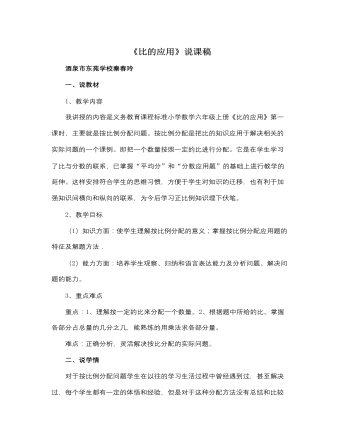
北师大版小学数学六年级上册《比的应用》说课稿
接下来引导学生分析题中数量关系:题目要分配什么?按照什么分配?重点思考讨论:从3:2这个比中,你能知道什么?接下来鼓励小组合作尝试多种方法解答,重点理解按比分配的方法。2、小结:按比分配的应用题有什么结构特点?怎样解答这样的应用题?这样设计为学生提供自主探索的空间。所以在教学中可以灵活地依据提出的方法调换教学顺序,并引导学生掌握两种不同的解题方法。安排学生的小组讨论方式能使学生一开始就畅所欲言,把几种不同思路比较和联系起来,在理解的基础上才能更好的掌握方法,并注意培养学生的检验能力。第三个环节:多层训练,形成技能。练习是数学课堂教学一个重要环节,我设计的练习题力求做到从易到难,由浅入深,有层次,有坡度,新旧知识融合恰当,形成技能技巧,开拓思维,发展能力,达到练习的预期目的。
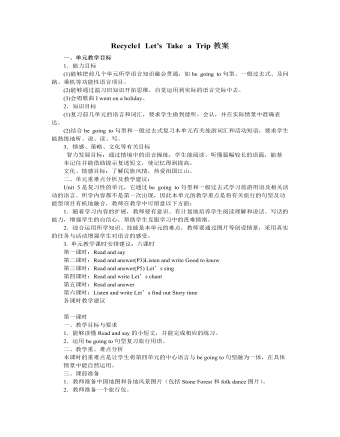
人教版新课标PEP小学英语六年级下册Recycle1 Let’s Take a Trip教案
4.巩固和扩展(Consolidation and extension) (1) 做本单元活动手册配套练习。 (2) 翻卡片说单词。学生两人一组,把单词卡片反面朝上放在桌子上,然后同时翻开两张单词卡(如:going, holiday),就马上组织成一句话(如:Where are you going on the holiday?/ I’m going to Kunming this holiday.),说得快又正确者为胜。 (3) 教师播放C部分Story time的录音或VCD,帮助学生理解故事内容。学生再听一遍录音,跟读故事里的句子,教师指导学生发音。 (4) Bright eyes. 在黑板上张贴Let’s find out的8幅图片,Mike, Zhang Peng, Sarah, Kathy等4个人物图片分别放在8幅图片上,如:Mike ---take pictures---buy presents。学生仔细观察后,请学生闭上眼睛,教师就趁学生闭眼之际交换人物位置(如把Mike放到eat noodles),然后请学生张开眼睛回答:What did Mike do just now ? 引导学生回答: Mike took pictures and bought presents. 教学参考资料库 1.文化背景介绍: 机场标志: Airport 飞机场 Airport lounges 机场休息室Airports shuttle 机场班车 Arrivals 进港Assistance 问讯处Check in area (zone) 办理登机区Departure airport 离港时间Departure times on reverse 返航时间 Welcome aboard 欢迎登机
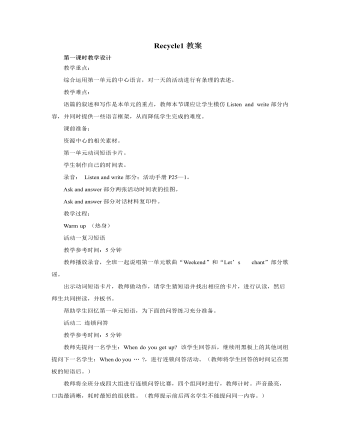
人教版新课标PEP小学英语五年级下册Recycle1教案(内容详细)
学生搜集中外重要节日及部分中外名人的生日所在的月份。教师准备相关节日及部分中外名人的图片或音像资料片。教师课前准备Let’s find out2的配图画好春、夏、秋、冬四个方框。录音:Listen and number。教学过程:Warm up (热身)活动一复习单词教学参考时间:3分钟(1)教师播放Let’s chant部分的歌谣,学生听一遍后跟唱。(2)出示带有各个月份特征的单词卡片。学生看图说出单词,并一起拼读其缩写形式。帮助学生在有节奏的说唱中巩固记忆单词,为在后面活动中学生能够熟练应用作铺垫。活动二 复习句子教学参考时间:5分钟(1)师生同唱Let’s chant部分歌谣“When Is Your Birthday?”。(2)教师引导学生看歌谣下面的翻滚过山车的动画,师生进行问答,如:When is the rabbit’s birthday? It’s in May. 等。教师示范后请学生进行Pair work,也可以展开竞赛的形式进行“连锁问答”。巩固有关生日问答的语句,为Let’s find out1的活动做准备。
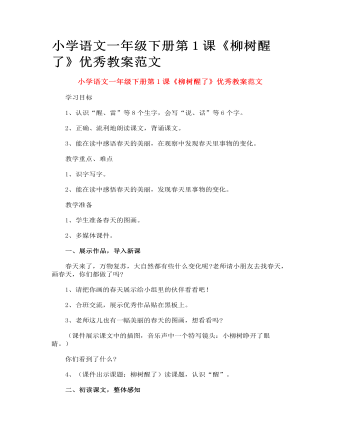
小学语文一年级下册第1课《柳树醒了》优秀教案范文
朗读背诵,感悟课文 1、你从什么地方知道柳树醒了?分小组交流交流。 (根据学生的回答依次学习相应小节。) 2、学生在读书交流中,随机出示课件中相应小节,帮助领悟,读好“醒、软、绿、飞、高”等词。 第一节:(课件出示:天空春雷一声响,地下一棵棵柳树摇了摇身子。) 想象:春雷会跟柳树说什么? 第二节:(课件出示:春雨沙沙,柳枝渐渐吐绿,向下垂。) 你觉得这一小节该怎样读呢? 第三节:(课件出示:春风吹动柳枝,柳枝飘荡) 引读,你们瞧!春风给柳树梳头,梳着梳着——(生读)。 第四节:谁想读第四节?谁知道“小柳絮”是什么样儿的?理解“柳絮”:(课件出示:一双燕子在空中飞来飞去,柳树上沾满上面结满有白色绒毛的种子,绒毛随风飞散。) 第五小节:(课件出示:柳树枝条在风中飘荡,孩子们在树下玩耍。)看,小柳树醒了,它在干什么?会班齐读。 3、再读读课文,想想:你从哪里知道“柳树醒了”?“柳树醒了”说明什么? 4、和同桌小伙伴一起试着背背课文,比比谁先会背。(课件出示课文插图,同时配乐。)
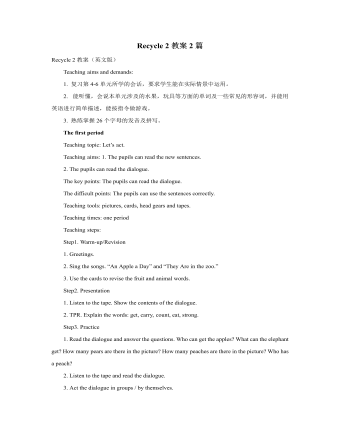
人教版新课标PEP小学英语三年级下册Recycle 2教案2篇
第三课时教学设计方案【教学内容和目标】【教学重点】 制作键盘; 学唱英文歌曲 “A B C Song ”。【教学难点】复习过程中的兴趣培养;【教具准备】1 教材配套的录音带。2 教师和学生分别准备废旧的硬纸盒/纸版、剪刀、胶水。3 教师准备一个自己已制作好的键盘。4 教师准备字母卡片和真正的键盘一个。【教学过程】1 热身、复习 (Warm-up/Revision)(1)师生之间进行英语对话或进行日常口语活动。(2)学生之间自编对话并表演。(3)教师播放B Let’s chant 的录音,让学生边拍手边说歌谣。(4)游戏:Silent Speech教师换一种方法说字母------唇说,说字母的时候不发出声音。学生看教师的口形,猜教师“说”的内容。说的字母为Aa----Zz 。2 呈现新课 (Presentation)(1)教师出示字母卡片,学生认读字母Aa----Zz。(2)学生字母背诵Aa----Zz。(3)教师播放歌曲 “A B C Song ”,告诉学生“试一试”“比一比”,看看谁能通过自己试唱学会歌曲。
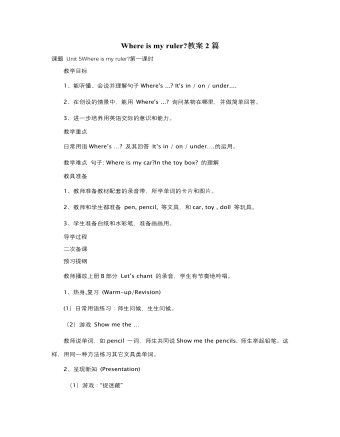
人教版新课标PEP小学英语三年级下册Where is my ruler教案2篇
1.Let’s say学习字母Uu, Vv, Ww,以及以这些字母开头的单词。2.Let’s do本部分通过有韵律的歌谣,来复习巩固A-W的字母。【教学重点】学习字母Uu, Vv, Ww及以其为首字母的单词【教学难点】单词umbrella, violin, wind和字母Uu, Vv, Ww的发音.【教具准备】1 教师准备教材配套的录音带。2 教师准备 umbrella, vest, violin, window, wind 的图片和词卡。3 教师准备字母卡 Aa----Ww 。【教学过程】1 热身、复习 (Warm-up/Revision)(1)Oral practice学生口语会话展示。教师可根据学生情况提示他们增加对内容。(2)游戏:“猜猜看”。教师用简笔画的方法在黑板上画某种交通工具的某个部位,边画边问:What is it? 学生随意想象,猜图说:A panda? A jeep? A pear? … 教师再继续画一两笔,让学生接着猜,并以小组为单位讨论,最后由一名学生代表说出一个答案。教师将图画完,带领学生一起说: Look! It’s a … 猜对的小组赢得一分。(以交通工具、玩具和文具词为主) 还可让学生代替教师进行此项活动。

人教版新课标PEP小学英语三年级下册At the zoo教案3篇
(二) 呈现新课 (Presentation)1、教师出示学过的缩略语PRCUKCANUSA让孩子读一读,然后拿出相应的卡片贴在黑板上请掌握较好的学生带着同学们读一读缩略语2、出示课文中的缩略语,让孩子们自己试着读一读,然后试着说说缩略语的含义3、听录音,跟读。小组说说4、让孩子们介绍自己收集的生活中的缩略语教师给以适当的扩充:CCTVWTOUFO等5、教师分别出示大小写Hh,让孩子想想大小写的字母分别想什么,用语言描述或是用动作表示。6、Let’s chant听录音,边听边打节奏听录音,边听边出示相应的字母听录音,边听边试着说歌谣孩子们带上自己的头饰,在小组中边演边说各小组展示(三)趣味操练(Practice)1、listen and order the cards让孩子说字母,按照听到的顺序排列字母2、listen and guess教师拼一拼缩略语,孩子快速说出词小组游戏(四) 扩展性活动(Add-activities)纸牌游戏两个孩子分别有一套学过的字母卡,按顺序出卡片,看谁能最先组成一个学过的缩略语。【板书设计】
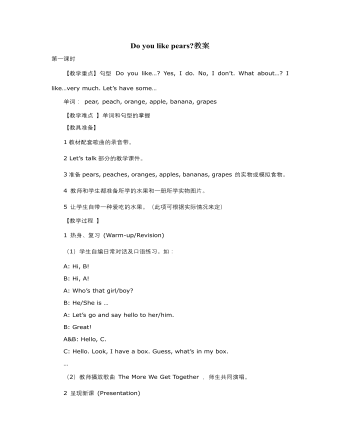
人教版新课标PEP小学英语三年级下册Do you like pears教案
教师扮做客人,让孩子根据问题做出反应并回答。 Can I have an apple? Can I have some grapes? Let’s sing 播放歌曲的录像,先观看一遍, 帮助孩子理解歌曲。 孩子边唱边表演。 小组表演,小组展示。 (四) 扩展性活动(Add-activities) Coloring Draw some grapes, color them red Draw a banana,color it green. …, …【板书设计 】Do you like pears? Do you like pears? 第五课时第六课时【课题】Do you like pears? 第六课时 【教学重点】听、说、认读字母Rr Ss Tt,体会字母在单词中的发音 【教学难点 】字母Ss的发音。Tiger中字母I的发音 【教具准备】 1、本课生词的单词卡片 2、配套的教学课件 3、相配套的教学录音带 4、学生的小英语练习本 5、大字母卡片,每组一套的小字母卡片 【教学过程 】 (一)热身/复习(Warm-up/Revision) 1、Let’s sing 演唱B部分的歌曲,边唱边演。
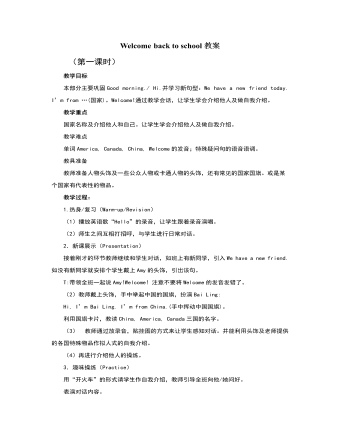
人教版新课标PEP小学英语三年级下册Welcome back to school教案
教学过程:1.热身/复习(Warm-up/Revision)(1)教师用肢体语言表示出字母,让学生猜出字母,并大声读出。(2)出示字母卡,学生认读,并提问学生回忆以它开头的单词。(3)放A部分Let’s chant的录音,学生有节奏地跟唱歌谣。2.新课展示(Presentation)(1)出示字母卡学习Dd,再单独呈现大写或小写,反复教读。用同样方法教读Ee。(2)出示以这两个字母为首字母的单词图片,问学生:What’s this ?回答:It’s a duck .教读duck,dog,egg,elephant。注意egg是an egg,不是“a egg”.(3)放Let’s say部分的录音,学生跟读。3.趣味操练(Practice)(1)呈现大写或小写字母的趣味图片,让学生认读。(2)让学生发挥想象,说出这些字母 像什么。(3)教师按笔顺书写字母,让学生观察后按笔顺书写字母。(4)游戏:找朋友游戏:看谁站得快学生手执卡片,听教师发令后,产成一排,下面的学生边读边检查。

人教版新目标初中英语七年级下册How was your weekend教案2篇
Teaching Goal:1. General aims:Talk about recent past events2. Particular aims:A. Language Focus.Talk about recent past events and think of the past events.B. Language goalsHow was….?It was …What did …do over the weekend?C. Language structures:(1). How was your weekend? I was great. Pay attention to no form.(2). What did you do over the weekend? I played soccer. We went to the beach.D. Useful words and phrases:Words: was, did, went, beach, over, project, test, wasn’t, false, number, geography, spend, week, most, mixture, their, had, little, cook, read, saw, change, everyone, sit, sat, no, anythingPhrases: did one’s homework, played soccer, cleaned my room, went to the beach, played tennis, went to the movies, on Saturday morning, over the weekend, cook … for, what about, do some reading, have a party, talk show, go shoppingE. Grammar language:Present simple past tenseRegular and irregular verbsF. Learning strategies:Tour and holidaysG. Interdiscipinary:H. Emotion and manner:Teaching time: 5 periodsTeaching procedures:Period One教学步骤、时间 教师活动 学生活动 媒体应用Step 1Free talk 3’ Ask some questions like:Who’s on duty today?What’s the weather like? Answer and talk about something.让同学们回答下列问题1. Do you like weekend? (Let some students answer)It takes them three minutes to talk about the question.2. Why do you like weekend? (let the students answer) Most of the students like the weekend此时教师用汉语问:“在周末期间问你干了什么?这句话用英语这么回答?Let the students guess.At last the teacher give them right answer3. What did you do over the weekend?(板书、学习)

